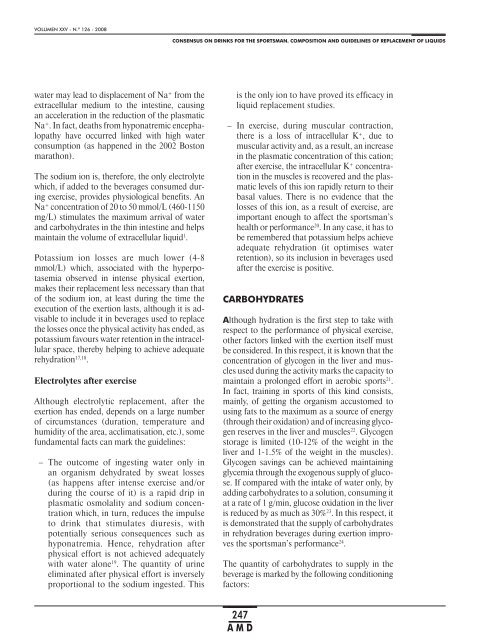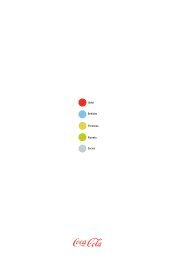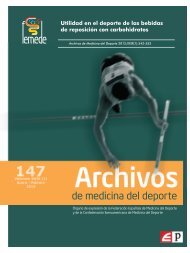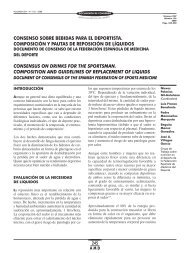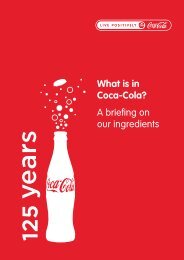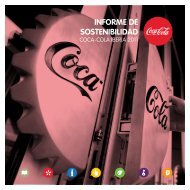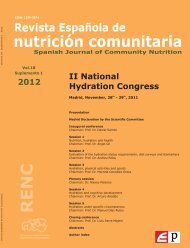de medicina del deporte - femede
de medicina del deporte - femede
de medicina del deporte - femede
You also want an ePaper? Increase the reach of your titles
YUMPU automatically turns print PDFs into web optimized ePapers that Google loves.
VOLUMEN XXV - N.º 126 - 2008CONSENSUS ON DRINKS FOR THE SPORTSMAN. COMPOSITION AND GUIDELINES OF REPLACEMENT OF LIQUIDSwater may lead to displacement of Na + from theextracellular medium to the intestine, causingan acceleration in the reduction of the plasmaticNa + . In fact, <strong>de</strong>aths from hyponatremic encephalopathyhave occurred linked with high waterconsumption (as happened in the 2002 Bostonmarathon).The sodium ion is, therefore, the only electrolytewhich, if ad<strong>de</strong>d to the beverages consumed duringexercise, provi<strong>de</strong>s physiological benefits. AnNa + concentration of 20 to 50 mmol/L (460-1150mg/L) stimulates the maximum arrival of waterand carbohydrates in the thin intestine and helpsmaintain the volume of extracellular liquid 1 .Potassium ion losses are much lower (4-8mmol/L) which, associated with the hyperpotasemiaobserved in intense physical exertion,makes their replacement less necessary than thatof the sodium ion, at least during the time theexecution of the exertion lasts, although it is advisableto inclu<strong>de</strong> it in beverages used to replacethe losses once the physical activity has en<strong>de</strong>d, aspotassium favours water retention in the intracellularspace, thereby helping to achieve a<strong>de</strong>quaterehydration 17,18 .Electrolytes after exerciseAlthough electrolytic replacement, after theexertion has en<strong>de</strong>d, <strong>de</strong>pends on a large numberof circumstances (duration, temperature andhumidity of the area, acclimatisation, etc.), somefundamental facts can mark the gui<strong>de</strong>lines:– The outcome of ingesting water only inan organism <strong>de</strong>hydrated by sweat losses(as happens after intense exercise and/orduring the course of it) is a rapid drip inplasmatic osmolality and sodium concentrationwhich, in turn, reduces the impulseto drink that stimulates diuresis, withpotentially serious consequences such ashyponatremia. Hence, rehydration afterphysical effort is not achieved a<strong>de</strong>quatelywith water alone 19 . The quantity of urineeliminated after physical effort is inverselyproportional to the sodium ingested. Thisis the only ion to have proved its efficacy inliquid replacement studies.– In exercise, during muscular contraction,there is a loss of intracellular K + , due tomuscular activity and, as a result, an increasein the plasmatic concentration of this cation;after exercise, the intracellular K + concentrationin the muscles is recovered and the plasmaticlevels of this ion rapidly return to theirbasal values. There is no evi<strong>de</strong>nce that thelosses of this ion, as a result of exercise, areimportant enough to affect the sportsman’shealth or performance 20 . In any case, it has tobe remembered that potassium helps achievea<strong>de</strong>quate rehydration (it optimises waterretention), so its inclusion in beverages usedafter the exercise is positive.CARBOHYDRATESAlthough hydration is the first step to take withrespect to the performance of physical exercise,other factors linked with the exertion itself mustbe consi<strong>de</strong>red. In this respect, it is known that theconcentration of glycogen in the liver and musclesused during the activity marks the capacity tomaintain a prolonged effort in aerobic sports 21 .In fact, training in sports of this kind consists,mainly, of getting the organism accustomed tousing fats to the maximum as a source of energy(through their oxidation) and of increasing glycogenreserves in the liver and muscles 22 . Glycogenstorage is limited (10-12% of the weight in theliver and 1-1.5% of the weight in the muscles).Glycogen savings can be achieved maintainingglycemia through the exogenous supply of glucose.If compared with the intake of water only, byadding carbohydrates to a solution, consuming itat a rate of 1 g/min, glucose oxidation in the liveris reduced by as much as 30% 23 . In this respect, itis <strong>de</strong>monstrated that the supply of carbohydratesin rehydration beverages during exertion improvesthe sportsman’s performance 24 .The quantity of carbohydrates to supply in thebeverage is marked by the following conditioningfactors:247A M D


